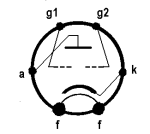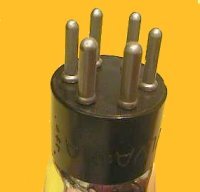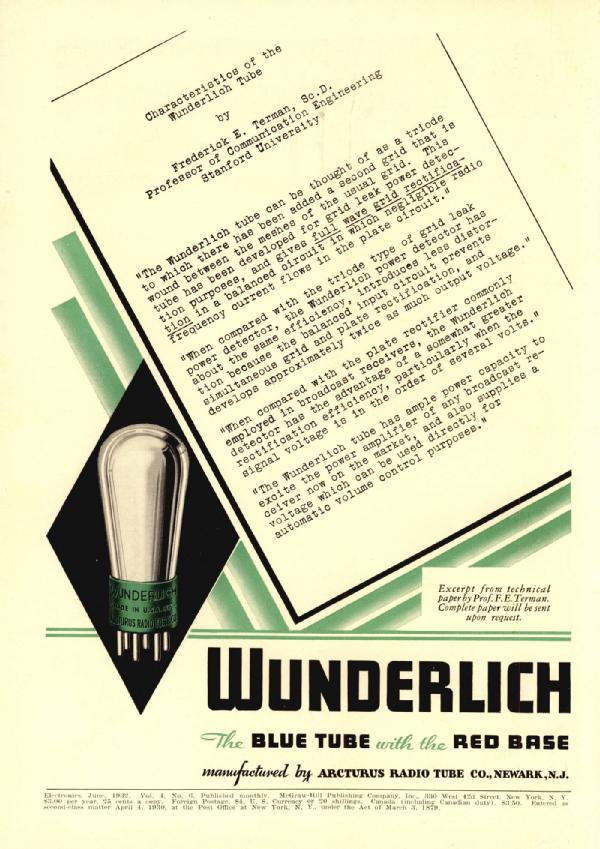
Wunderlich
|
|
|||||||||||||||||||||||||||||||||||||||||||
|
Hits: 3706 Replies: 1
Wunderlich operational details
|
|
|
Joe Sousa
13.Sep.11 |
1
Fellow Radiophiles:
As conditions deviate from the ideal, the difference in gains between the two grid paths will produce a small ripple at the carrier frequency. With larger signals, say, when enough of the 3/2 gm power law is traversed for 10% distortion, a 2x carrier signal will emerge at the plate as each positive peak is amplified with a different gain from the negative peak between the two grids.
Input loading of the peaks will also produce this slight distortion which results in 2x carrier content at the plate. All this is true for an unmodulated input carrier with RC biased grid leak detection. The capacitor in the RC grid leak is essential because it keeps the grids DC-biased at mid carrier amplitude. When modulation is applied, then there will be a small carrier frequency ripple that has the amplitude of the audio increment from cycle to cycle. The unfiltered plate ripple will be greatest with 100% audio modulation at fastest modulation frequency of 4kHz. The low mu=12 for the two grids driven together, as they are driven by the audio signal developed at the grid leak, and the plate bias via a large resistor to a high Bplus and effective AGC, should eliminate the cutoff type of distortion that is common with triode grid leak detectors driven with large signals with a low fixed bias at the plate, as was the case with battery sets of the 1920's. It would take 250V/12=-21V at both grids to cutoff the Wunderlich plate in the schematic shown above.
This photo shows this principle with 60Vp-p at each grid but with an input frequency of 160Hz to insure accurate fullwave tracking at the grids. This insight came up from my design effort with the class AB p-p design of the Gammatron output stage in Sputnik. Curve traces
The following plots show that a negative bias on one grid causes the curve family for the other grid to be shifted to the right. The second plot has a -20V bias on one grid, which caused with curve family for the other grid to move it's zero bias trace to the -18V position. This shows that the fields of the two grids add fairly linearly to control plate current in this 0-20V range.
This plot shows Gammatron style operation of the Wunderlich, where the plate is tied to one grid for the output voltage sweep, while the other grid is stepped at -2V/step. Note that the horizontal scale is reduced to 2V/div. Nearly all current in this plot flows through the grid that is tied to the plate. The plate carries little current. This illustrates the potential application of the Wunderlich as a more efficient alternative to a space charge tetrode in low plate voltage applications. Space charge tetrodes employ the first grid as a space charge grid that draws a wasted current that is much larger than the plate current.
The following three plots sweep one grid while stepping the other grid with negative steps, while the plate is held fixed at 0V, +50V and +200V. Note how the effect of one grid over conduction by the other grid is neutralized by positive Anode voltages. These plots are useful to predict detection behaviour at the grid.
It seems that the salient feature of the Wunderlich, as compared to a conventional grid leak detector, is that there is much less carrier signal current at the plate. A filter cap can be added to the plate, but this already functions as the second pole in the envelope filter. The very effective rejection of the carrier means that a faster grid-leak can be used with higher ripple because there is a second opportunity to filter without danger of diagonal distortion at the plate. The nearly constant and low impedance of the plate eliminates all danger of diagonal distortion there, thus making it a preferable spot for filtering. The plate impedance will be constant on a steady state basis, but will increase for stronger signals, as the grid leak circuit generates a negative grid bias. ReferencesDie Wunderlich Röhren by Wolfgang Holtman (I read this German language post with the Google translator) Questions about the Wunderlich tube by Wolfgang Holtman "The Wunderlich Detector" by Ludwell Sibley, Tube Colector December 2006 Vol-8, no6, p33. Lud's article includes an extensive list of 12 references, many of which are contemporary with the Wunderlich tube. "Wunderlich's B tube" by Ed Lyon, Radio Age Jan 2000 pp. 1, 3, 8-9. Ed Lyon was very kind to lend me his Wunderlich detector for these measurements. Thank you, Ed. Best regards, -Joe |
|
Ernst Erb
02.Apr.12 |
2
At the moment we show about 40 models with Wunderlich tubes and 14 different types of tubes. In many cases it is the same tube with other designation but as a reference work we have to show all. This type of a Wunderlich tube is the most known - with nearly 40 models. You find the models by clicking the tube and then scrolling down the tube page to click the presented models, sorted by model year.
But we find also a car radio from Sparks-Withingon, Sparton 34 with the type 70. This was confused with the type 70 current regulator - until a guest, Ron Wing, Wichita, KS, USA, told me. He added: "In the book "The Collector's Vacuum Tube Handbook" by Robert T. Millard, The Sparton Model 34 is given as the only known model that used a 70." By the way: The Wunderlich A with 5 pin and a top contact must have used also in radios I believe - but we have not yet listed a model for it.
Lud Sibley published an article "The Wunderlich Detector" in the TCA Tube collector bulletin Volume 8, Number 6 - December 2006 about "A discussion of circuits, variants, and radios that used them". His list covers:
Grillecloth.com shows the
From Mallory-Yaxley (3rd and 5th edition): 11 models:
Sylvania shows additional: |
|
Hits: 1039 Replies: 0
Electronics 1932: The Wunderlich tube
|
|
|
Achim Dassow
01.Dec.19 |
1
Dear Members and Visitors of the RM,the evaluation of the first volumes of "Electronics" is yielding fruits: The Wunderlich tube Notes on the Wunderlich tube * |
|
Hits: 1112 Replies: 0
Electronics 1932: Die Wunderlich Röhre
|
|
|
Achim Dassow
01.Dec.19 |
1
Liebe Mitglieder, liebe Besucher des RM,Die Auswertung der ersten Jahrgänge der "Electronics" trägt Früchte: Die Wunderlich Röhre Diese negative Spannung kann für die Einrichtung einer AVC verwendet werden. Nach der Detektion arbeitet die Röhre als Audio Verstärker parallel mit beiden Gittern. Bemerkungen zur Wunderlich Röhre*
|
End of forum contributions about this tube
| Data Compliance | More Information |




 There is a misconception in the usual understanding of plate ripple performance with push-pull detection in the Wunderlich. With perfectly matched drives and grid gains, with the plate biased for linear audio amplification, there is no 2x carrier ripple at all at the plate, even without any capacitor filtering at the plate.
There is a misconception in the usual understanding of plate ripple performance with push-pull detection in the Wunderlich. With perfectly matched drives and grid gains, with the plate biased for linear audio amplification, there is no 2x carrier ripple at all at the plate, even without any capacitor filtering at the plate.










